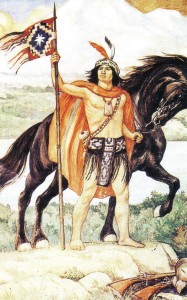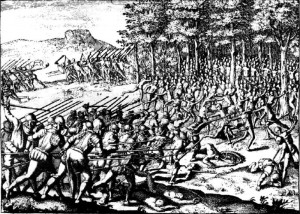| Lautaro | |
|---|---|
 |
|
| Mapuche Military Commander | |
| In Power | 1553-1557 |
| Born | 1534 Treguaco |
| Died | 1557 Maule |
| Nationality | Mapuche |
| Military Title | Toqui |
Lautaro (1534 – 1557) was a young Mapuche leader and warrior in the four year Arauco War, which took place during the first phase of the Spanish conquest of Chile. In Spanish, Lautaro’s name means swift hawk. He was born in the jungles of Carampangue y el Tirua. Being the chief’s son, he lived a relatively normal life until he was captured at the age of 11 years old by Spaniards.
Lautaro Becomes a Slave
Only 11 years old when he was captured, Lautaro was put through a process called “yanacona”, which means servitude. The slaves, called “yanos”, were taken by the Spaniards from their communities effectively breaking all ties with them. The word has changed in meaning throughout the years and there remains a cultural divide in how different countries in South America use it.
Lautaro became the personal pageboy of Pedro de Valdivia, a fame hungry Spanish conquistador. His duties included looking after Valdivia’s horses and estate. His presence was necessary when the Spaniard went into battle or attended military meetings. During this time, Lautaro learned to ride a horse well and studied as much military strategy as possible, despite his situation.
Because Lautaro was a yano, he often had to serve alongside the Spaniards in battles. He became close with captain Marcos Veas, who showed him how to use some weapons and taught him basic military strategy.
Lautaro’s access to the Spaniards gave him an advantage later on in life. Lautaro escaped from slavery in 1552 and returned to his people. Armed with new military knowledge and strategic insight, he organized his army and introduced horses to his soldiers. Lautaro’s exposure to European culture allowed him to unite the Mapuche people in various successful attacks against the Spanish.
The Atrocity of War
During his time in forced servitude, Lautaro saw the way that his master Valdivia treated defeated Mapuches. His methods were inhumane and torturous, often mutilating prisoners and showcasing them in an attempt to deter future rebellious attitudes.
This is thought to have greatly affected Lautaro and may have radically changed his outlook in regards to the Spaniards and his own people. After witnessing the atrocities of the Spanish, he began trying to escape. It took him two years and as many attempts before he was successful.
Escaping from Spanish Encampment
Lautaro escaped the Spaniards in 1552. He took a horse with him and returned to his people. He also took the captain’s cornet, a popular wind instrument used by many armies at the time. His escape was of no particular interest to the Spaniards and they chose not to pursue him at all.
When he returned, tensions were running high. However, they settled as Lautaro showed himself to be a natural leader. He taught his people how to ride horses and use them in battle, something the Mapuches were unfamiliar with before they encountered the Spaniards.
While preparing for war, Lautaro called many open air meetings to teach his people the military arts and how to use weapons. He also prepared the people with a solid military strategy. With everything in place to attack the Spaniards, Lautaro was elected Toqui, the title granted to the highest military leader of Mapuches in war.
Military Strategist
With the political and military knowledge that he had acquired through his many years as a slave, Lautaro knew what type of offensive he would have to use against the Spaniards. During the Batalla de Tucapel, he managed to trick the Spanish conquistadors and capture an emissary. This emissary told him that Valdivia was heading south and needed to go through Tucapel.
Mapuche soldiers followed and let him make his way through without attacking. This seemed a little strange to Valdivia, particularly the fact that he had not received news from Bobadilla, one of his men who he had sent to look ahead on the journey.
The Battle of Tucapel
 On Christmas day in 1553, he returned to find that the Spaniard fort had been completely destroyed. Even so, Valdivia decided to push on and set up camp in the ruins of the fort. Only when he had nearly finished this did the Mapuche ambush him. Even with this disadvantage, the Spanish conquistador managed to hold off the attack.
On Christmas day in 1553, he returned to find that the Spaniard fort had been completely destroyed. Even so, Valdivia decided to push on and set up camp in the ruins of the fort. Only when he had nearly finished this did the Mapuche ambush him. Even with this disadvantage, the Spanish conquistador managed to hold off the attack.
Though their numbers were dwindling, the Spanish managed to resist two more waves of warriors. However, when the third squadron showed up, it was Lautaro himself that led the attack. The Spaniards surrendered, and the Mapuches took the soldiers prisoner.
What happened to Pedro Valdivia is not known. Some versions say that he was sentenced to death after a trial, whereas others say that he was tortured for days until he died. The battle of Tucapel was decisive, as it allowed Lautaro to take over several cities that were under Spanish rule in Southern Chile over the next few years.
The Toqui Dies
Lautaro led several successful conquests against the Spanish. However, as his ambitions increased, fewer warriors committed to his cause. When he decided to attack Santiago, his numbers had deflated to less than 1000 warriors. None the less, Lautaro sought to win the city.
He and his 800 Mapuche men were attempting to sneak up on the city while its main force was occupied elsewhere. However, the Spaniards were informed of their presence by an indigenous man. The Spaniard captain, a man called Francisco de Villagra, immediately fetched Captain Godinez so that they could attack the Mapuches.
It is said that once the Spaniards attacked the Mapuche encampment they went directly to the chief’s house, which he shared with his wife Guacolda. Lautaro went outside with Valdivia’s sword in his hand and was hit by a spear and killed.